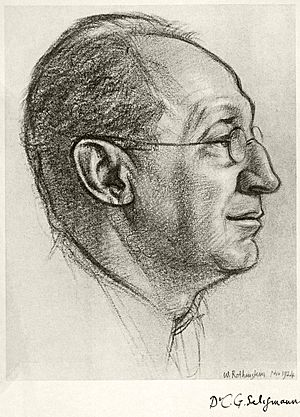Charles Gabriel Seligman facts for kids
Quick facts for kids
Charles Gabriel Seligman
|
|
|---|---|
 |
|
| Born |
Charles Gabriel Seligmann
24 December 1873 London, England
|
| Died | 19 September 1940 Oxford, England
|
| Citizenship | British |
| Alma mater | St Thomas' Hospital |
| Known for | Races of Africa (1930) |
| Scientific career | |
| Fields | Anthropology, history |
| Influences | Giuseppe Sergi |
| Influenced | Bronisław Malinowski E. E. Evans-Pritchard Meyer Fortes |
Charles Gabriel Seligman (born Charles Gabriel Seligmann; 24 December 1873 – 19 September 1940) was a British doctor and ethnologist. An ethnologist studies different cultures and peoples. He was known for his work on the Vedda people in Sri Lanka and the Shilluk people in Sudan.
Seligman was also a professor at the London School of Economics. He taught many famous anthropologists. These included Bronisław Malinowski and E. E. Evans-Pritchard.
Seligman supported a theory called the "Hamitic hypothesis." This idea suggested that some African civilizations were started by people from outside Africa. Today, this theory is seen as white supremacist and is completely rejected by scientists.
Contents
Life and Career
Charles Seligman was born in London in 1873. His family was Jewish and his father sold wine. Charles later shortened his last name from Seligmann to Seligman.
He studied medicine at St Thomas' Hospital. After working as a doctor for a few years, he joined an expedition. This was the 1898 Cambridge University expedition to the Torres Strait.
He then went on more trips to study different cultures. He visited New Guinea in 1904. He also went to Ceylon (now Sri Lanka) from 1906 to 1908. Later, he traveled to Sudan from 1909 to 1912, and again in 1921–1922.
In 1905, Seligman married Brenda Zara Salaman. She was also an ethnologist. They went on many expeditions together. Brenda was good at languages. She could observe ceremonies that Charles was not allowed to see. He always gave her credit in his books.
From 1913 to 1934, he was a professor at the London School of Economics. The anthropology department's library is named after him. He was also a Fellow of the Royal Society. This is a group of important scientists.
Works and Ideas
The Hamitic Hypothesis
Seligman is known for his book Races of Africa (1930). In this book, he described what he believed were four main "races" in Africa. These were the Bushmanoids, Pygmies, Negroids, and Caucasoids (Hamites).
Seligman strongly believed in the "Hamitic theory." This theory suggested that "Hamitic" people from North and Northeast Africa brought civilization to the continent. He thought they introduced new languages and technologies.
He wrote that "the civilizations of Africa are the civilizations of the Hamites." He believed these "Hamites" were "pastoral Caucasians." He thought they were "better armed as well as quicker witted" than the "dark agricultural Negroes."
Seligman divided the "Hamites" into two groups. These were "Eastern Hamites" and "Northern Hamites." He believed these groups were related to people from the Mediterranean region.
He also thought that "Hamites" and "Semites" (like Jewish and Arab peoples) came from the same original group.
Since the 1960s, the "Hamitic hypothesis" has been completely rejected. Scientists now know that these ideas about "race science" are wrong and harmful.
About Races of Africa
When Races of Africa was first published in 1930, it received good reviews. It was seen as an important book about African cultures. Many universities used it in their history and anthropology classes.
The book was updated several times. Seligman published a second edition in 1939. Later editions in 1957 and 1966 were updated by other anthropologists. The book was reprinted until 1979. Even though it was widely used, its main ideas about "races" are now outdated and incorrect.
Selected Works
- Melanesians of British New Guinea (1910)
- The Veddas (1911) with Brenda Seligman
- Some Aspects of the Hamitic Problem in the Anglo-Egyptian Sudan (1913)
- Races of Africa (1930, 1939, 1957, 1966)
- The Pagan Tribes of Nilotic Sudan (London: Routledge, 1932) with Brenda Seligman
His and Brenda's writings are kept at the London School of Economics.

